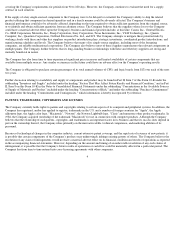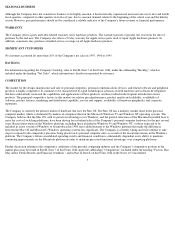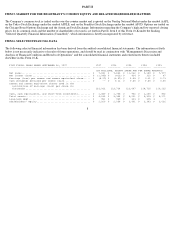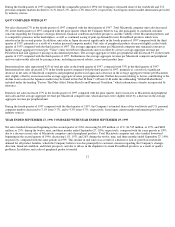Apple 1997 Annual Report Download - page 17
Download and view the complete annual report
Please find page 17 of the 1997 Apple annual report below. You can navigate through the pages in the report by either clicking on the pages listed below, or by using the keyword search tool below to find specific information within the annual report.the heading "Factors That May Affect Future Results and Financial Condition," which information is hereby incorporated by reference.
GROSS MARGIN
Gross margin represents the difference between the Company's net sales and its cost of goods sold. The amount of revenue generated per unit
sold is influenced by the price set by the Company for its products. The cost of goods sold is based primarily on the cost of components and, to
a lesser extent, direct labor costs. The type and cost of components included in particular configurations of the Company's products (such as
memory and disk drives) are often directly related to the need to market products in configurations competitive with other manufacturers.
Competition in the personal computer industry is intense and, in the short term, frequent changes in pricing and product configuration are often
necessary in order to remain competitive. Accordingly, gross margin as a percentage of net sales can be significantly influenced in the short
term by actions undertaken by the Company in response to industrywide competitive pressures.
Gross margin increased from 10% to 19% of sales during 1997 compared to 1996, primarily as a result of a $616 million charge in the second
quarter of 1996 that related principally to the write-down of certain inventory, as well as to the cost of cancelling excess component orders
necessitated by significantly lower than expected demand for many of the Company's products, primarily its "Value" line of Power Macintosh
products (formerly generally referred to as entry level and Performa-Registered Trademark- products). The Company separately incurred
approximately $145 million in charges during 1996 to provide for the estimated costs of correcting certain quality problems in certain of its
"Value" line of Power Macintosh products, as well as PowerBook and peripheral products, covering both goods held in inventory and shipped
goods. In addition, gross margins in the second quarter of 1996, and to a lesser degree the first quarter of that year, were adversely affected by
aggressive pricing actions in Japan in response to extreme competitive actions by other companies, as well as price reductions in the United
States and Europe across all product lines in order to stimulate demand.
Gross margin decreased from 22% to 20% of sales during the fourth quarter of 1997 compared to the same period of 1996, and remained
constant compared to the third quarter of 1997. This was primarily as a result of certain pricing actions effected by the Company as noted
above, as well as the Company's inability to fulfill all purchase orders of certain high-margin Power Macintosh product due to the
unavailability of sufficient quantities of certain components, which were offset to varying degrees by sales of the Company's new operating
system, Mac OS 8, during the fourth quarter of 1997.
The gross margin levels in the fourth quarter of 1997 compared with the third quarter of 1997 and the fourth quarter of 1996, and in 1997
compared with 1996, were also adversely affected by a stronger U.S. dollar relative to certain foreign currencies. This negative impact was
offset by currency hedging. The Company's operating strategy and pricing take into account changes in exchange rates over time; however, the
Company's results of operations can be significantly affected in the short term by fluctuations in foreign currency exchange rates.
There can be no assurance that the Company will be able to sustain the gross margin levels achieved in 1997. Gross margins will remain under
significant downward pressure due to a variety of factors, including continued industrywide global pricing pressures, increased competition,
and compressed product life cycles. In response to these downward pressures, the Company expects it will continue to take pricing actions with
respect to its products. The Company expects to experience additional pricing pressure through at least the first fiscal quarter of 1998 as a result
of the Company winding down its Mac OS licensing program, including the acquisition of its Mac OS license and other assets of Power
Computing Corporation ("PCC"), as the Company expects certain Mac OS licensees to sell aggressively their remaining inventory in early
fiscal 1998. Gross margins could also be affected by the Company's ability to
14
























